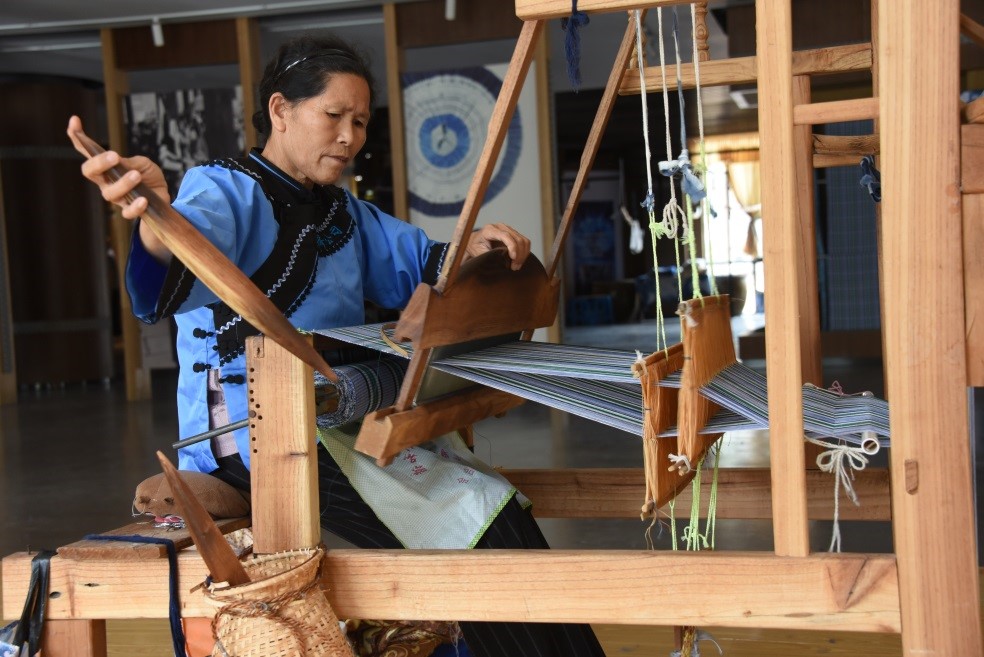

 |
| Photo shows a senior woman of the Buyi ethnic group weaves cloth with a loom. Photo by Su Bin, People’s Daily |
Speaking of the Buyi ethnic group in southwest China’s Guizhou province, the first thing that comes into people’s mind is its traditional and unique ethnic costumes.
Ceheng, a county lying on the southwestern corner of Guizhou province, is the largest area inhabited by the Buyi ethnic group in China. It is also the place where Nanpanjiang River and Beipanjiang River meet. Living in such a hot and humid climate, the local people regard homespun clothing as the first choice as it is comfortable to wear.
40-year-old Huang Lian has been helping her mother make clothes since childhood. As an experienced clothes maker, she has won multiple awards in costume contests.
“We use a wooden spinning wheel to make yarn, a loom to weave cloth and indigo to dye the cloth,” Huang introduced. “The most complicated part is dyeing with indigo, which takes a number of procedures and about 20 days to finish,” she added.
The Buyi costumes, in different shades of blue, are a representative project of national intangible cultural heritage, and the blue clothes have become a symbol of the Buyi ethnic group.
However, clothes dyed by the natural and traditional technique lose color. Though the dyestuff indigo doesn’t harm human skin, it affects the marketing of the clothes, as few customers are willing to buy clothes that fade.
A great opportunity happened in 2017, when a man named Long Zhiyu came to Ceheng from Yunnan province. Long was very interested in Buyi dyeing and established a company that manufactures Buyi clothes.
Long invited experts from the school of textile science and engineering in Tiangong University in north China’s Tianjin municipality, and after field investigations and repeated experiments by the experts, the color-losing was no more a problem.
“Before dyeing, villagers always put something in the dye vat for a certain period of time,” Long disclosed, explaining that this is similar to fermentation, during which the bacteria grow to strengthen the dyeing effects.
After rounds of screening and experimenting, the experts discovered a bacterial strain with strong reducing capacity. “The bacterial strain could help reduce the dyeing process from more than 20 days to just 3 hours, and the color fastness is better,” Long said.
The new technology has revitalized the ancient dyeing technique. But Long and his team decided to go further. They divided the color of the cloth into 12 levels, from light blue to dark blue, further refining the dyeing technique.
“Recently, we received orders placed from Japan and South Korea worth more than one million yuan ,and we’ll deliver the goods soon,” said Long. After breaking through the technological bottleneck, Long became more confident in the dyeing and processing of the clothing.
“The ethnic costumes, made from natural materials and environmental-friendly, are very competitive in the international market,” Long introduced.
Supported by the new technology, Long’s company established a relatively complete industrial chain.
“Under an agreement we signed with indigo growers, our company provides indigo saplings for the farmers to grow and purchase indigo leaves from them at a price no lower than the market price,” said Long, adding that this business model has helped impoverished farmers increase income.
“Indigo is a treasure plant. Its leaves could be used as a dye and its root is a constituent of Radix Isatidis. This is why it’s not a low-price product,” said Luo Chengsong, an impoverished farmer whose net profit of every 667 square kilometers of indigo field stood at 2,800 yuan. The man, who had planned to work outside town in the past, finally decided to make a living in his hometown. Now he is planning to increase the planting area of indigo trees by 0.2 hectares.
“At least 66.67 hectares of indigo trees are needed each year by us for production, and the figure keeps increasing,” said Long, expressing the hope that while facilitating the development of the indigo industry, his company could lift more impoverished households out of poverty and help them become well-off.
 |

 Award-winning photos show poverty reduction achievements in NE China's Jilin province
Award-winning photos show poverty reduction achievements in NE China's Jilin province People dance to greet advent of New Year in Ameiqituo Town, Guizhou
People dance to greet advent of New Year in Ameiqituo Town, Guizhou Fire brigade in Shanghai holds group wedding
Fire brigade in Shanghai holds group wedding Tourists enjoy ice sculptures in Datan Town, north China
Tourists enjoy ice sculptures in Datan Town, north China Sunset scenery of Dayan Pagoda in Xi'an
Sunset scenery of Dayan Pagoda in Xi'an Tourists have fun at scenic spot in Nanlong Town, NW China
Tourists have fun at scenic spot in Nanlong Town, NW China Harbin attracts tourists by making best use of ice in winter
Harbin attracts tourists by making best use of ice in winter In pics: FIS Alpine Ski Women's World Cup Slalom
In pics: FIS Alpine Ski Women's World Cup Slalom Black-necked cranes rest at reservoir in Lhunzhub County, Lhasa
Black-necked cranes rest at reservoir in Lhunzhub County, Lhasa China's FAST telescope will be available to foreign scientists in April
China's FAST telescope will be available to foreign scientists in April